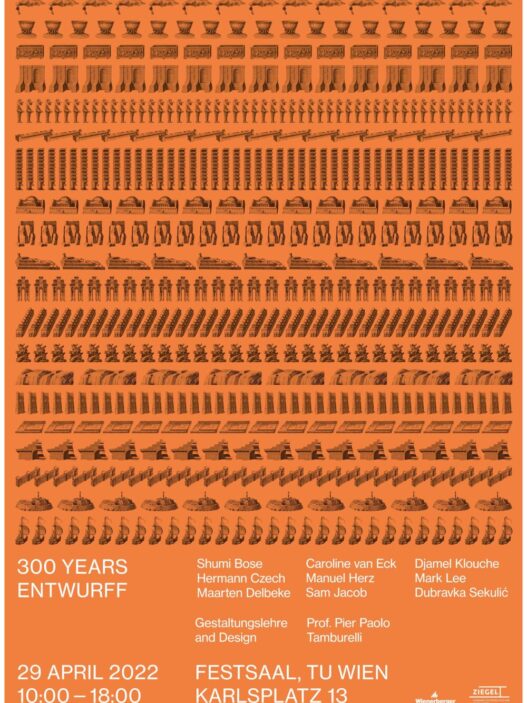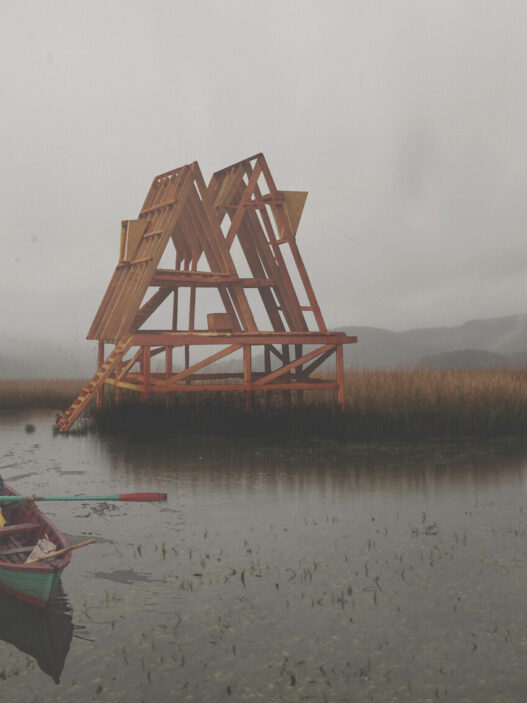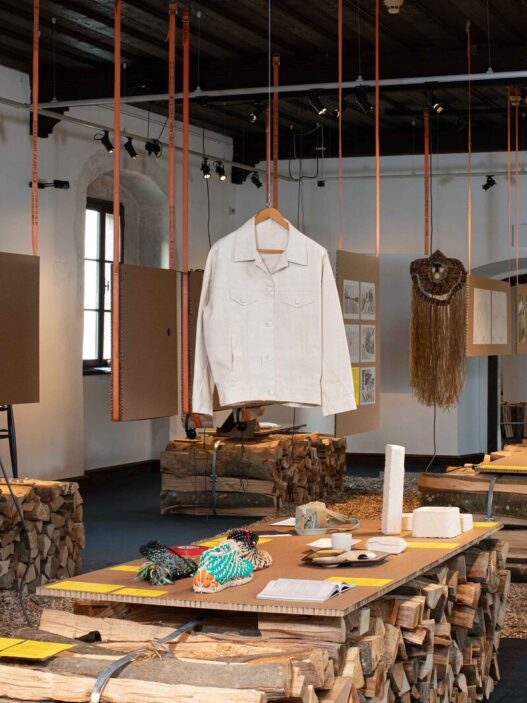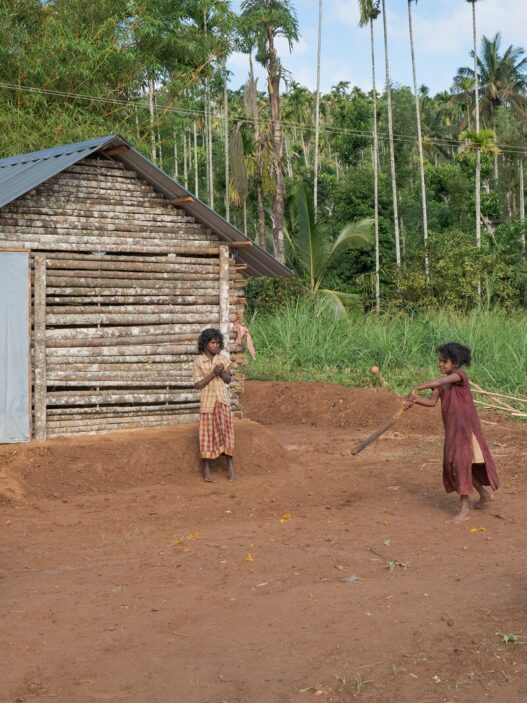New Times (Made in Slovenia)
Milano Design Week 2022
June 7–12, 2022
Press preview: June 6, 11am–7pm
New Times is the exhibition of new products that have been awarded the “Made in Slovenia” mark of excellence. The title of the exhibition featured at the 2022 Milan Design Week references Modern Times, the 1936 silent comedy film written and directed by Charlie Chaplin, in which his iconic Little Tramp character struggles to survive in the industrialised modern world. The film is a commentary on the desperate employment and financial conditions that many people faced during the Great Depression—conditions that, according to Chaplin, were created by the (in)efficiencies of modern industrialisation. Fordism, standardised mass production, and consumption have ultimately led to alienation between the consumer and the producer. In today’s market, mass produced goods appear in an extremely impersonal form, as a “commodity fetish.” Corporations hide the origin of goods and social circumstances in which they were produced, preventing users from having a say in the products they buy.
This is why New Times stands in dialectical contrast to Chaplin’s Modern Times. The pandemic, climate change, and alienated and stratified social relations call for radical systemic change. The products we are presenting offer a critique of the existing market, and economic and social systems, they break with established, often bad social habits, and bring new uses to the fore. What’s more, they have the potential to become serial products or services that no longer use the established modes of serial production.
They all share the desire to reveal not only the final product, but the background of the product development process, and the idea of using good design to build a community. These not-so-subtle messages reiterate the value of handmade versus machine-made. Perhaps this is nothing more but replacing one fetish (technologically perfected mass production) with another (imperfect and handmade). It could be that in Western culture, which is saturated with brands and cheap, mass-produced goods, we romanticise handcraft because it is quality not quantity that we crave. At the same time this craving reveals the divide between Western consumers who are rediscovering handicraft and the other, poorer part of the world, countries that have local craftspeople but pursue a course of industrialisation. Nevertheless, mass production still offers a solution that can lift people out of poverty—so how can the two coexist?
The designers we are presenting are looking for ways to reconnect people into a community, motivate them to look up from their screens and take notice of the people around them. And if craftsmanship, in Richard Sennett’s words, names the basic human impulse, it is about focusing not only on developing our own skills, but also on ourselves and the community. We crave things that mean something to us, that bring us closer to like-minded people, contribute to one’s psychosocial empowerment and build community spirit. Then there is the sense of freedom we get and the environmental responsibility that we demonstrate when we use these products.
With her Olive vases Brina Steblovnik aspires to preserve and develop manual glass shaping skills, which are gradually being lost to robots. Darja Malešič’s Pra carpet and the modern embroidered self-portrait SELFI by Zavod Oloop engage their users. Both use handwork as a tool for personal and community psychosocial user empowerment through design—the Pra carpet by taking the corn husk tradition from the community and bringing it to the modern home, and SELFI with an ironic take on the “selfie,” engaging the user by creating a therapeutic needlepoint image of themselves. The transition from the digital to the material is at the heart of Kobeiagi Kilims’ Pattern Generator project, which engages carpet buyers in hand production through computer-controlled co-creation of the final product. Each carpet is a one-off, conceived from the buyer’s words that the algorithm renders into a unique pattern.
The second group of products seek and employ more environmentally friendly materials. The Krater capsule is made of biocomposites, which could potentially replace plastic packaging or thermal insulation. The capsule holds a tea ceremony cup, which comes from wild urban clay collected on a construction site and is an alternative to industrial ceramics. Material exploration cum tea ceremony … In her Fragile Bodies project young artist Maruša Mazej looks at disposable objects. By freezing them into structured ceramic products she transforms them into objects of special value. Lučka Berlot and Ági Göb on the other hand have taken pieces of plastic harvested from the sea and frozen them into a semi-transparent composite material that resembles colourful terrazzo. The pieces were collected by volunteers from environmental NGOs and various communities on the coasts of Greece, Croatia, Slovenia, and Italy.
Last, but not least, Primož Jeza’s oneandhalfmilionchair also breathes in the spirit of new times. Made from shredded banknotes it treats money as a waste material generated by an overly industrialised society that has dematerialised money. Which is why it should, as a waste material, be recycled into something more durable—like a chair.
The third section showcases state of the art products, such as the first electric outboard RemigoOne and Versi heat pump. In addition to energy efficiency, they both seek new functionalities that bring users more freedom and independence—RemigoOne with its compact unibody, mobility and the option to be charged from any existing solar source, and Kronoterm Versi with its compactness that makes it suitable for use in apartment buildings.
Designers Miha Artnak and Srđan Prodanović are convinced that we can only come together as a society under the common flag of planet Earth by leaving our cultural, national, and other differences represented by national symbols aside. Their message is that after we’ve been separated by the pandemic, discrimination, racisms and nationalisms, mistrust of state institutions, economic stratification, and climate change, it is design that can bring us back together.
So see you in new times!
Contact
Centre for Creativity, Museum of Architecture and Design (MAO)
Rusjanov trg 7, 1000 Ljubljana
T +386 (0)41 381 858 / [email protected]














![[1] Quadros, chapéus e botas, Banga ossa, 2020. [2]: Arquitetura na Periferia. Photo: Pedro Thiago Silva. [3] Espíritos de Tudo que Vive, Uýra. Photo: Selma Maia, 2019. [4] Visual identity of the 13th International Architecture Biennale of São Paulo: Travessias.](https://dailyart.news/wp-content/uploads/2022/05/travessias-527x703.gif)


